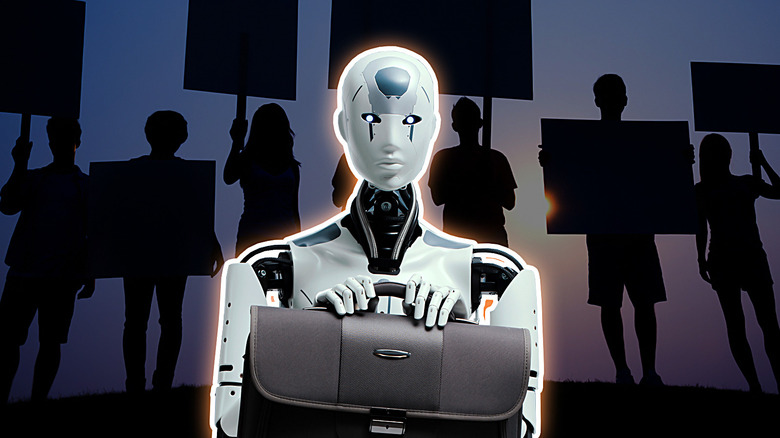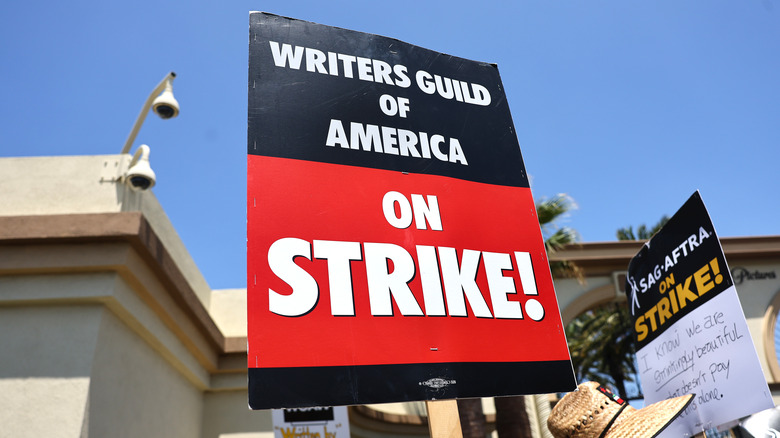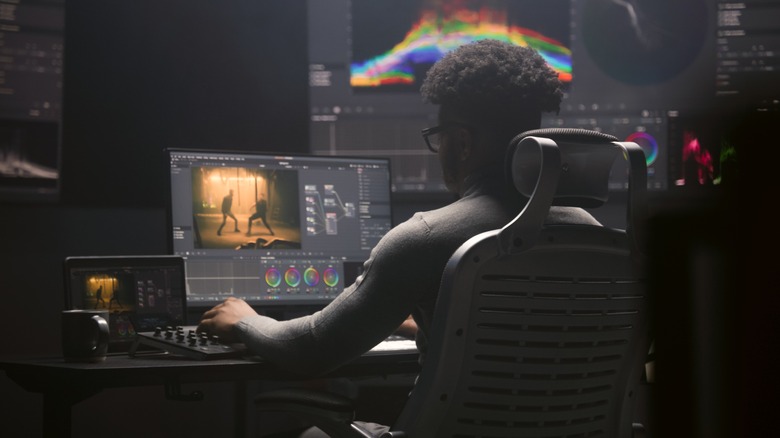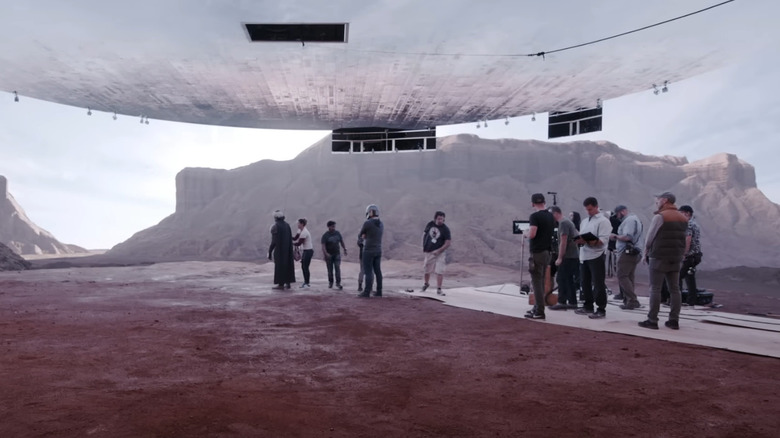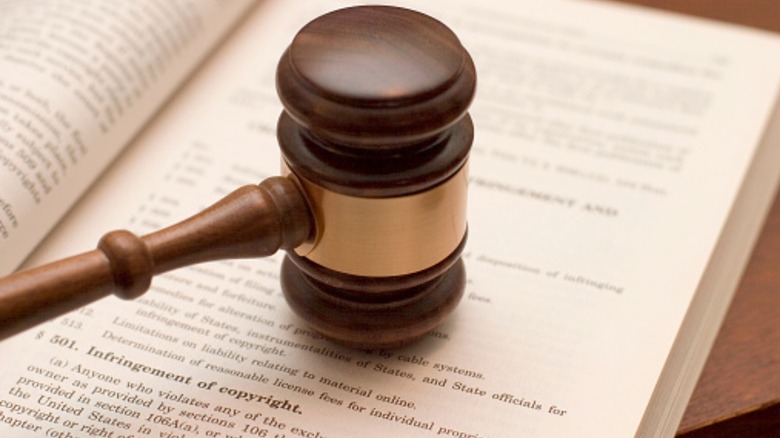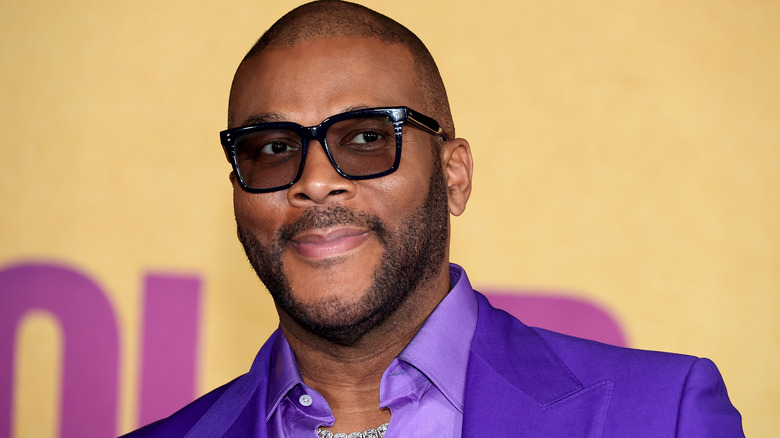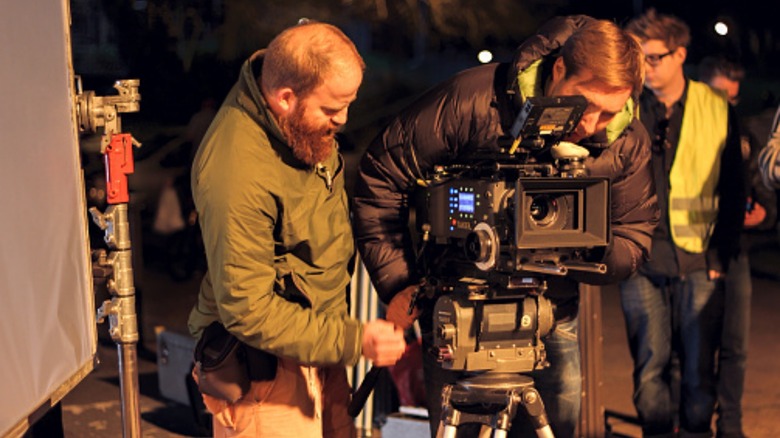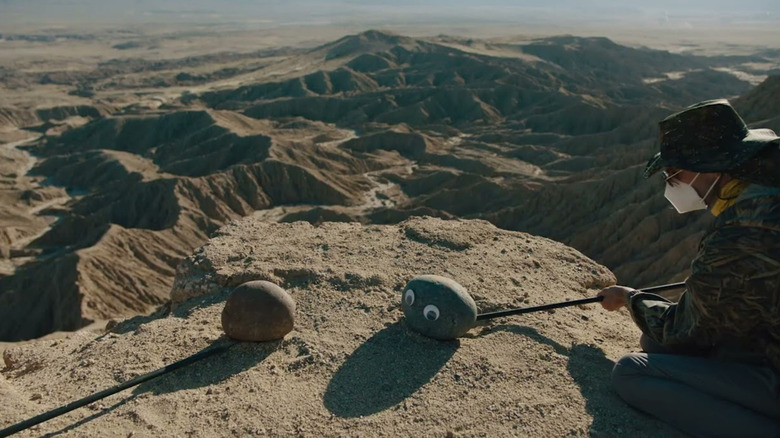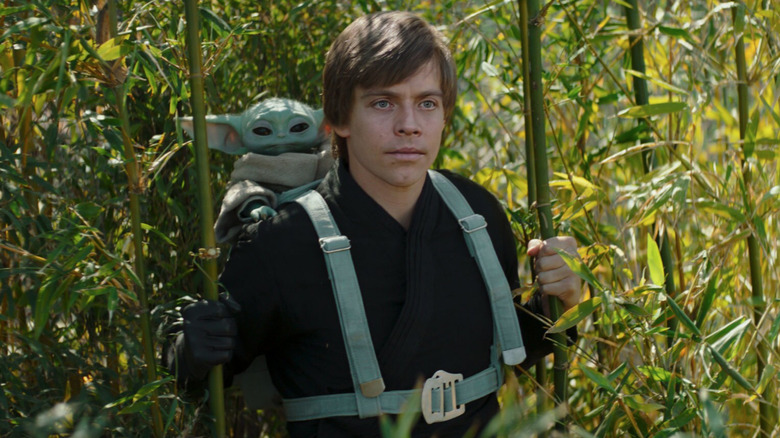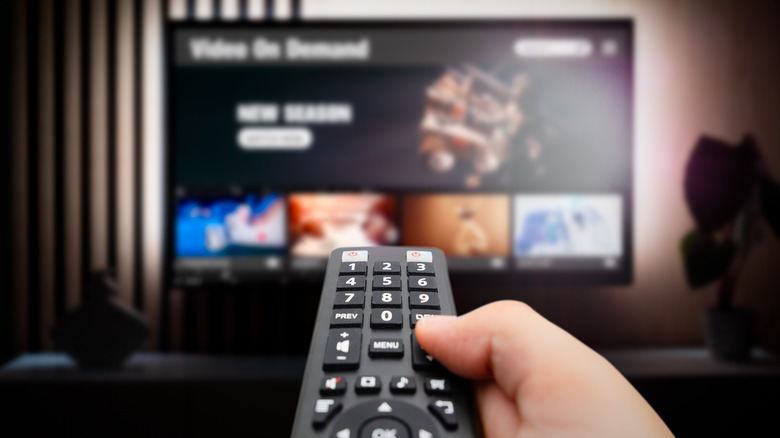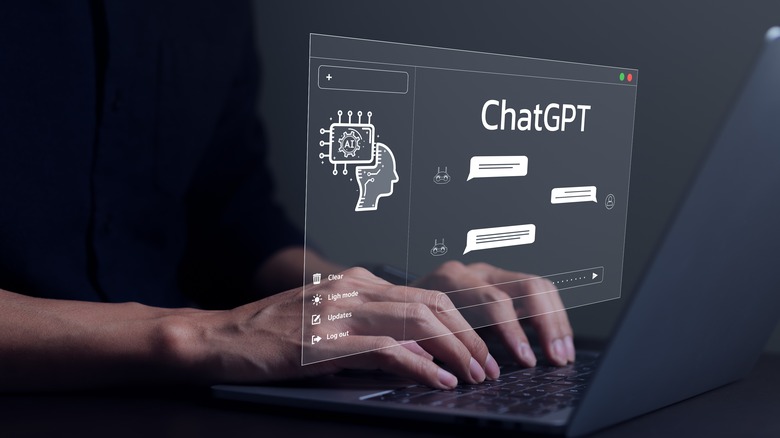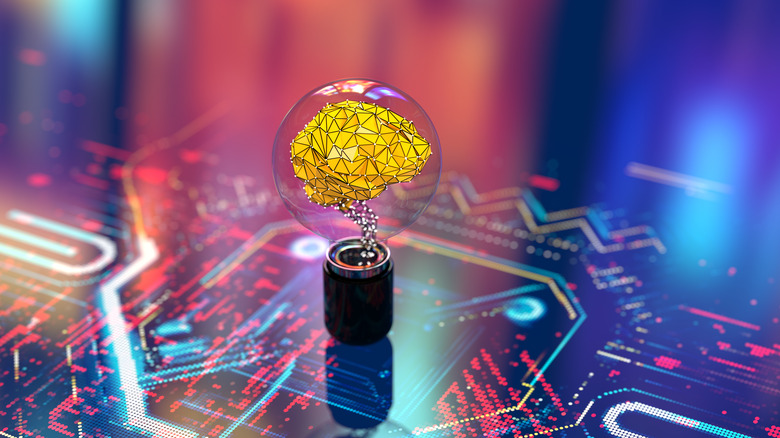Big Changes Are Coming To Movies And TV Because Of AI
Recent developments in generative artificial intelligence (GenAI) are quickly transforming our way of life. With AI models like chatbots, text-to-image, text-to-video, and others becoming more widely accessible to the public, we've entered a new era of opportunity and possibility. But in capitalist America, the first thing one thinks in the face of this revolutionary technology is, "How can it make me money?" From the service industry and sales to art and entertainment, industries have taken notice of the potential that these rapid advancements have to positively or negatively impact labor as we know it.
In the wake of the 2023 Hollywood labor union strikes involving the trade association The Alliance of Motion Picture and Television Producers (AMPTP) and the unions Writers Guild of America (WGA) and Screen Actors Guild-American Federation of Television and Radio Artists (SAG-AFTRA), the entertainment industry at large took notice of the sudden rise of GenAI and what was at stake. Among the several points of contention in the labor disputes, actors and writers shared a similar concern regarding the unprecedented use of AI as a way to replace or undermine creatives.
Although all parties have since reached their respective agreements, the complex relationship between AI and entertainment is far from settled. As GenAI programs continue to advance and new ones take shape, we'll continue to see big changes in movies and TV that affect both creators and consumers.
AI remains a looming threat to labor
The WGA and SAG-AFTRA's tentative 2023 agreements with the AMPTP set necessary, transformative restrictions regarding the use of AI to protect the rights of writers and actors. The regulations in the WGA's minimum basic agreement dictated that AI-generated content isn't recognized as traditional material, writers may opt to use AI with company consent, disclosure of AI-generated content to writers is mandatory, and the Guild retains the right to challenge the exploitation of writers' work for AI training purposes.
Similarly, SAG-AFTRA's agreement outlined terms and conditions governing the use of AI in creating, replicating, and altering performers in films, requiring notice and bargaining for the use of "Synthetic Performers" in place of human performers, mandating semi-annual meetings to discuss GenAI usage, and addressing similar aspects for background actors' digital replication and alteration, all aimed at ensuring equitable treatment, compensation, and protection of workers' rights in filmmaking.
While these measures do a lot to protect actors and writers for now (partly relying on studios' willingness to self-regulate between contract renewals), many other entertainment sectors remain exposed to AI's potential to disrupt labor. "This is the first step on a long process of negotiating and working through what GenAI means for the creative industry," David Gunkel, a professor of media studies at Northern Illinois University, told The Guardian. "Not just writers but visual artists, actors, you name it." Meanwhile, as state-level AI legislation takes hold, we'll likely see a push from workers across all industries for broader national regulations.
AI impacts all film and TV departments
While no department goes untouched by AI, post-production work finds itself especially exposed to the technology's accelerating advancements. With contract negotiations between The Animation Guild (TAG) and the AMPTP quickly approaching, TAG commissioned a study on the impact of GenAI on entertainment jobs to gauge where 300 industry leaders stood on the matter. Citing the WGA and SAG-AFTRA's successful strikes as precedent, the report underscored the risks faced by the creative workforce and the future of entertainment in the absence of a thoughtful and deliberate approach to integrating GenAI with necessary safeguards.
While it will take some time to see the true cost of studios' overzealous embrace of GenAI to increase productivity and revenue, three-fourths of survey respondents indicated GenAI has already contributed to the displacement of jobs within their divisions. Looking ahead, two-thirds anticipate roughly 203,800 payroll jobs being displaced within the next three years, with sound editors and 3D modelers flagged as the most vulnerable by a third of respondents and sound designers, compositors, and graphic designers close behind.
Meanwhile, in a separate Variety Intelligence Platform survey, entertainment professionals were asked to identify tasks they anticipate GenAI will effectively perform in the next two to three years. Notably, more than half chose tasks these tools are already conducting, like creating sound effects, autocompleting code for game programming, and producing artwork for film, TV, or game storyboards. A more positive perspective suggests that GenAI could benefit workers by streamlining tasks with the automation of time-consuming processes. Again, the future relies upon strong union and legal safeguards.
The next step in visual effects
In modern cinema, it's rare to come across a movie that doesn't utilize visual effects (VFX) to some degree. This sentiment is also increasingly becoming true for television. Every single one of the top 10 movies at the domestic box office over the past three years was either driven by VFX or a computer-animated film. From the rise of practical effects during the Golden Age of Hollywood to advancements in computer-generated imagery (CGI) in the '80s and beyond, VFX technology has undergone a significant evolution in filmmaking.
One of the newest breakthroughs in VFX is the advancement in real-time rendering technology, allowing filmmakers and VFX artists to create high-quality visual effects in real time rather than relying solely on post-production rendering. While these newer techniques aren't as accessible to your average independent filmmaker, affordable and relatively intuitive software has made VFX as a whole more accessible. However, AI has the power to level the playing field even more.
AI is being increasingly adopted as a cost-effective and time-saving tool to automate specific VFX tasks, including facial animation, performance capture, visual enhancements, and more. Beyond that, GenAI models like OpenAI's text-to-video model Sora can now generate entire scenes and, soon enough, fully AI-generated features. Even when considering all of its flaws, AI technology is currently blurring the lines between real and fictional worlds in visual storytelling.
Reshaping copyright laws
Advancements in AI technology are prompting a reassessment of copyright law, particularly concerning authorship, infringement, and fair use regarding AI-generated content. Currently, copyright laws do not cover content generated by non-human entities, while regulations involving infringement, fair use, and AI detection remain limited. In the WGA and AMPTP's 2023 contract, studios seemingly retained the right to use writers' work to train AI, with the Guild reserving the right to assert instances of exploitation. However, there are still legal hurdles studios must contend with. As courts navigate the use of the new technology, copyright infringement lawsuits against GenAI models are beginning to pop up across all creative sectors.
Artists are also navigating a gray area when it comes to work created in part by using AI tools. According to a statement from the U.S. Copyright Office (via The Hollywood Reporter), a creation containing elements of AI must demonstrate human input in a "sufficiently creative way that the resulting work constitutes an original work of authorship" to be eligible for copyright protection. But exactly how much human input is enough to warrant copyright protection? Registrants must also disclose all AI components in their work for copyright protection. However, verifying their accuracy without reliable AI detection methods remains a challenge.
Only more court cases on AI copyright issues will set precedents that truly clarify AI's impact on copyright. Alongside union-backed protections, the absence of copyright for AI-generated work keeps studios concerned with protecting IP from further utilizing the technology.
Industry professionals are reevaluating their business
While the entire entertainment industry adjusts accordingly to the unstoppable force of AI, industry professionals are reevaluating their business strategies in huge ways. For one, when the data and analytics resource Cinelytic launched its AI-driven project management system in 2019, Warner Bros. was one of many studios to sign a deal with the company to inform which kind of projects are more likely to resonate with audiences and generate the most revenue. While this integration doesn't negate a human touch to decision-making, it's evident that studios are leaning heavily on algorithms to influence which projects get the greenlight and which don't.
More recently, OpenAI's launch of its text-to-video model Sora was enough to shock filmmaker Tyler Perry into rethinking his $800 million studio expansion plans. Seeing Sora's capabilities, Perry has now paused this expansion indefinitely. "For me, I'm looking at my business and the bottom line, but I'm also very concerned about all the people that I have trained and bought up in this industry. I'm concerned about what will happen to them," Perry told The Hollywood Reporter. Aware of both the positive and negative potential of GenAI, Perry has mindfully adopted AI in two of his upcoming films by replacing hours' worth of aging makeup with GenAI post-production tools. His ultimate plea: "I think the only way to move forward in this is to galvanize it as one voice, not only in Hollywood and in this industry, but also in Congress."
More options for independent filmmakers
One of GenAI's more positive aspects is its ability to present more opportunities for independent filmmakers, who are often constrained by smaller budgets. If major studios seek to utilize the technology for their bottom line, what stops the little guy from doing the same? What once took millions of dollars worth of equipment, time, and labor can now be achieved with GenAI tools (within limits).
Big-budget genres like science fiction and fantasy can now be explored in new and exciting ways by just about anyone. "We don't know where the next Spielberg, who might be some kid in some village somewhere, is from. Right now it's almost impossible to discover some of these voices," Nikola Todorovic, co-creator of the AI-driven software Wonder Dynamics, told Time. "We want to build tech to give access globally, as opposed to people having to move to L.A. and break into the industry a certain way."
However, it can also be argued that as GenAI continues to render numerous entry-level positions obsolete in the coming years, breaking into the industry will inevitably prove more difficult for these same independent filmmakers. With the right tint of rose-colored glasses, embracing GenAI sounds fine as long as filmmakers approach the technology as a collaboration rather than supplanting creativity entirely. Otherwise, you're merely generating prompts, not creating a film.
AI has been among us for years
AI's presence in Hollywood is becoming steadily more prominent, but it's actually been utilized in film and TV productions for years, albeit still heavily reliant on human input. For example, two films nominated at the 92nd Annual Academy Awards for best visual effects, "Avengers: Endgame" and "The Irishman," both openly used AI-powered VFX to their advantage.
In "Avengers: Endgame," the machine learning system Masquerade was developed to realistically render Josh Brolin's performance into the fully digital villain, Thanos. For "The Irishman," the visual effects company Industrial Light and Magic developed the ILM Facefinder software to de-age actors Robert De Niro, Al Pacino, and Joe Pesci. "AI and machine learning are becoming a part of everything we do in VFX," explained "The Irishman" VFX supervisor Pablo Helman to Animation World Network. "Paired with the NVIDIA Quadro RTX GPUs powering our production pipeline, these technologies have us excited for what the next decade will bring."
In another example, "Everything Everywhere All At Once" VFX artist Evan Halleck turned to Runway AI tools to automate rotoscoping for the movie's rock scene. "I was cutting out the characters, placing them cleanly on a plate shot in minutes versus what takes half a day," Halleck explained to Variety. Nevertheless, these instances offer only a glimpse of how studios openly embrace AI. Undoubtedly, numerous other productions have quietly integrated AI technology to varying degrees. We stand on the brink of AI taking on increasingly significant roles in film and TV production.
AI in television
The landscape of television has shifted significantly, with bigger-budgeted productions now becoming the standard. What was once reserved for theatrical blockbusters — high-concept premises, immersive VFX, and A-list star power — can now all be experienced from the comfort of your couch in the form of an episodic series. Moreover, these larger budgets also mean more money to spend on technology like AI, which has unsurprisingly made its way into your favorite TV shows as well.
Look at HBO's "The Righteous Gemstones," where lead actor John Goodman was de-aged with the help of Shapeshifter, a cutting-edge AI software that analyzes facial motion, similar to the ILM Facefinder used in "The Irishman." Marvel Studios also used AI in collaboration with Method Studios to create the opening sequence for "Secret Invasion." LucasFilm followed suit, with Disney+'s "The Book of Boba Fett" taking a more overt approach to AI by deepfaking the youthful look and voice of Mark Hamill as Luke Skywalker onto actor Scott Lang, a move that left viewers both fascinated and unsettled. Similarly, in the "Obi-Wan Kenobi" series, the iconic voice of Darth Vader, James Earl Jones, was recreated using AI voice tools per the actor's permission. With studios like Marvel and LucasFilm at the forefront of entertainment openly embracing AI, we'll likely see more companies employ these same techniques in the near future.
AI algorithms are reshaping content relevance and engagement
AI algorithms are revolutionizing the way content is produced and consumed on streaming platforms. These algorithms, which parse through mass amounts of data, are essential for driving engagement by matching the right content with the right viewers and guiding creators on what content to produce next. The movies and TV shows recommended to you on your favorite streaming platform's homepage are carefully curated based on your watch history. The types of genres you gravitate toward, how long you watch, and even the time of the day you watch are all considered when determining your personalized algorithm. Netflix takes this one step further by using AI to tailor its thumbnails to suit personalized preferences and to enhance streaming quality even at lower bandwidths.
However, like everything regarding AI, there are concerns about ethical risks surrounding these AI-powered algorithms, including data privacy and security, as well as algorithms potentially favoring certain content over others. Views on AI integration across entertainment, from development to production to distribution, vary greatly. Some consider it an essential evolution, while others see it as unwittingly fulfilling a prophecy that sidelines humans from the creative process.
AI video and AI writing are still deeply flawed
Despite the significant strides made in GenAI technology, there's still a considerable distance to cover before AI-generated content can match the creative intuition, emotional depth, and narrative complexity inherent in human storytelling. Even with the impressive capabilities of models like OpenAI's ChatGPT and Sora, which can be prompted to write screenplays or craft scenes, the resulting content often fails to reach the heights of creativity achieved by human writers and filmmakers.
This discrepancy stems from the fact that these AI models are trained on existing human works, leading to a lack of originality and innovation in the generated content. In the case of text-to-video-generated content, visuals often lack realism and tend to fall into the uncanny valley — the unsettling feeling evoked by human-like representations that are almost, but not quite, lifelike.
While AI has shown promise in revolutionizing content creation in film and television, human guidance remains indispensable. Many hurdles still lay ahead before AI-generated content can match the richness and complexity of human storytelling. With the proper regulations and safeguards, we can hope for a future with AI technology that enhances rather than replaces the creative talents of human filmmakers and storytellers.
Does AI empower or stifle creativity?
As artists are presented with the ultimatum to either embrace AI or be weeded out, this begs the question of whether AI ultimately empowers creatives, by giving them access to previously unattainable tools, or stifles creativity as we know it. As of right now, we lack AI tools capable of producing art and stories that rival the realism and creativity achievable by humans. However, with how fast the technology has evolved in recent years, there's no doubt we will soon see AI capabilities closing the gap and even surpassing human creativity. Let's hope the proper restrictions and regulations are implemented before we get to that point where one can't distinguish a human-made film from an AI-generated one.
While acknowledging the subjectivity inherent in all art, including that generated by AI, the notion of AI dominating the creative landscape overlooks the fundamental essence of art itself, which is rooted in individual expression, emotion, and interpretation. While access to AI can inspire boundless creativity and streamline efficiency, it remains a double-edged sword that requires careful consideration and a mindful approach that prioritizes humanity's well-being.
